How are we looked at?
2009-03-09 | Articles0. Introduction
There are a lot of studies that corroborate what the art and the advertising knew a long time ago: the movements of the eye keep a close relation with some psychological processes and mechanisms of the persons.
Different visual follow-up technologies through eye-trackers have allowed demonstrating determined aspects related with the attention and the perception of the persons. And knowing the mechanisms through which we process the visual information we can work the images so as to control the form in which they will be looked at. This article will show us, how.
1. How do we process the visual information?
Let’s start understanding how our brain processes the information we see. We can distinguish two well-differentiated forms.
Through an automatic process: which is superficial, quick, unconscious and cannot be inhibited.
The semantic content – meaningful – of the scene (such as the forms and the colors) can attract the attention and modify the ways of visual exploration.
We know it also as “botton-up” process or “macroreading” of the image, making reference to the generic exploration and merely contemplative of it.
In the following painting of Gerrit van Honthorst we can observe the existing relation between the light and darkness zones of the image and its later exploration measured in the laboratory.
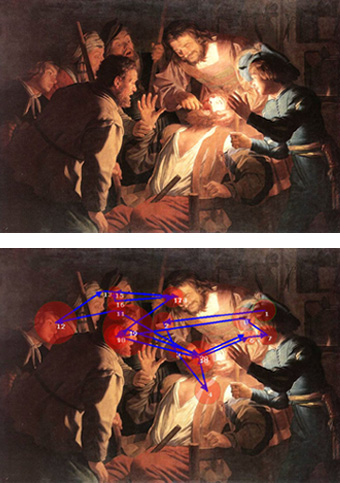
Later the advertising would adopt this and other art techniques. In this advertisement we see how the figure’s posture forces are related, the contrasts and the trajectory that the eyes keep while observing the image.
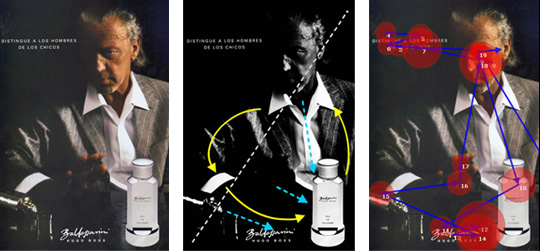
There is another controlled process that is more slow and conscious, as the reading.
This is a more complex one as it depends on several variables (in the case of the reading essentially from the previous learning of the language, that is clear). But there are others.
2. The conditioned observation
Previous objectives decided the observation strategies of the persons
The investigation of visual movements is being developed in a more or less experimental manner for the last 100 years. However, the results outside the academic environments have started to be known.
The experiment of Alfred Yarbus, though dating from 1967, is still the most relevant one within this field.
Yarbus demonstrated how the previous motivations and objectives of the observer before a scene decided completely the observation strategies of the persons.
His experiment consisted in registering the visual movements of the participants while contemplating a painting. They had 3 minutes to observe a scene about which they previously knew questions which they had to answer. The idea was that they had to observe the image of the painting with the aim of looking for leads to help them knowing the answer.
The results could not be more enlightening. To different questions different visual exploration patterns about the work.
The implications of this demonstration are more than evident, especially in very active environments or of high cognitive processing, as it might be surfing the Internet or watching a movie, for example.
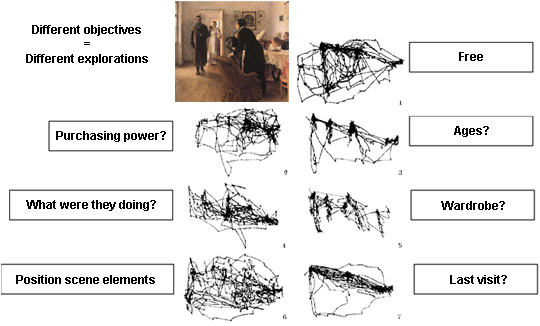
3. The perceptive organization
The perception is the process through which we choose, organize and interpret the stimulus to grant a coherent meaning to the world that surrounds us.
Therefore the psychology of the Gestalt postulated the idea that the stimulus had to be considered as a whole (holistic perspective) and that our perception of a part depended also on the remaining ones.
In the first example, we see how we are able to see beyond the circles of the image. The second example is so known as valid. We are confused by the scale of the central circle depending if it is surrounded by other smaller ones o bigger than it.

Also the appearance of a color might change as regards the surrounding colors. Nothing new for the "tenacious” painters (of the expressionist movement named fauvism from the beginning of the century XX), known for the intelligent use of the pure and complementary colors.
The works of Matisse and the modern fauvist Thad Morgan are two good examples.
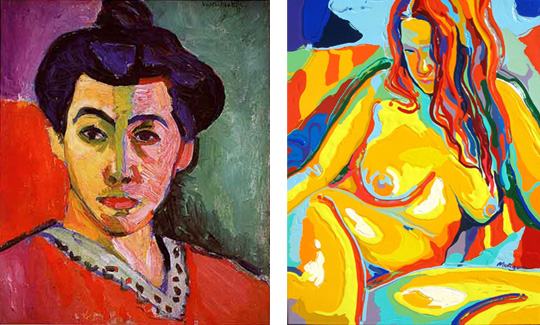
So, the perceptions are complex experiences, a result of the integration of multiple sensations and not the sum of them all (analytical perspective).
Said integration is organized according to our wishes or needs (we should remember the experiment of Yarbus) and might be affected by the memory of the previous experiences of the preceptor subject (and of course his culture).
4. Keys of the perceptive processing
We auto-complete meanings (text and images) to give them meaning.
A good example might be the form in which we are able to recognize - and reed - these texts without the need to having all the necessary details.

We leak the information at maximum
The human evolution opted for media economy in the perception matter.
At a visual level we do not see in detail more than 2% of the field that we are able to cover. Then we perform a biased reading of what we are looking at, so as to be able to use this information in the most optimum and possible manner, in order to understand it and act quickly accordingly,
We should not forget that there are concepts that we have biologically pre-programmed, as the sex.

Learning
The importance that the psychology and sociology have in fields like the graphic advertising design is not fruit of the chance, as the previous learning has a remarkably influence on our perceptive mechanisms.
To give an example, we know the "Processed Z Pattern" as the tendency to carry out an exploratory look that starts in the upper left part of the sheet going down later.
This reading gravity is a habit that has been learnt and inherited from our occidental culture, which we found, applied in the design of magazines, advertisements and web sites.
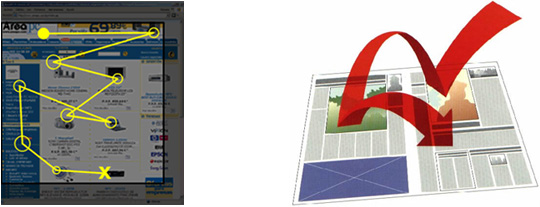
5. How are we looked at?
There are many formulas, but these are the most used ones:
Direction of the figures´ glance
The recognition and attraction that we have towards our fellows make it to use faces of persons in advertising very frequently. Moreover, the postures or the direction of the glances indicate us to way we have to follow.
In the advertisement we see how these directions are combined with the final slogan to conclude landing in the announced product.
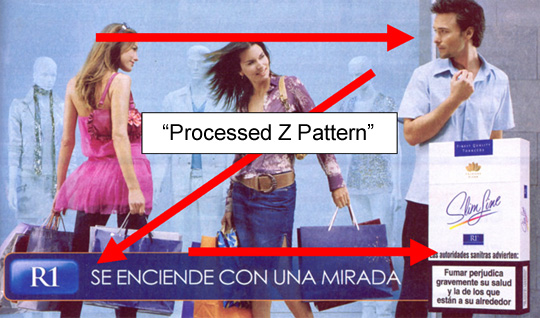
Composition and framing
The disposition of the objects in the scene creates a series of forces that suggest continuity in the scene narrative reading.
These simple schemes show us ways of grouping the information (similarity of color, size and form) in order to be able to rank it later highlighting some groups and hiding others.

In order to finish it has to be remembered that the type of approach used in the photography has an influence in the person’s decisions taking and opinions, turning it into a persuasive and powerful tool, either with political or advertising aims. It is not enough that we carry out a critical glance about the news we read in the daily press, it is necessary to be conscious of the meaning of the images that are shown to us, how they are created and why they have been chosen.
As it is well pointed out by Facundo Tomás in his book “ Escrito, pintado”:
“The perceptive schemes are modified according to the photographic guidelines: the photography imposes a manner of seeing and indicates a way for the vision”.
